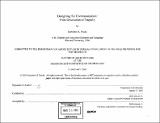Designing for communication : from orientation to empathy
Author(s)
Fricke, Gretchen M., 1974-
DownloadFull printable version (18.10Mb)
Other Contributors
Massachusetts Institute of Technology. Dept. of Architecture.
Advisor
Bill Hubbard, Jr.
Terms of use
Metadata
Show full item recordAbstract
Beyond shelter, communication is the essential act of architecture. The construction of a building is the result of a dialogue between people and the natural environment where a building rises because it is the physical fulfillment of people's needs and desires that are not naturally met. Because buildings are designed for people, it is reasonable to define a building'S success by the degree to which it is relevant to and usable by people. A building'S relevance, whether it be physical, historical, or spiritual, occurs through communication. This thesis proposes that architects should make communication a design priority. We have the ability to and should take upon ourselves responsibility for creating, maintaining, and heightening people's physical and emotional relationships to their world. The design subject for this thesis is a retreat center for artists, writers, and musicians. Because visitors come to a retreat center for short periods of time (usually 2-4 weeks), the necessity for understanding and relating to one's environment is concentrated and immediate. A retreat center must communicate quickly and meaningfully to its creative inhabitants in order for them to feel at ease, connected, and able to progress in their work.
Description
Thesis (M.Arch.)--Massachusetts Institute of Technology, Dept. of Architecture, 2003. Includes bibliographical references (leaves 62-67).
Date issued
2003Department
Massachusetts Institute of Technology. Department of ArchitecturePublisher
Massachusetts Institute of Technology
Keywords
Architecture.